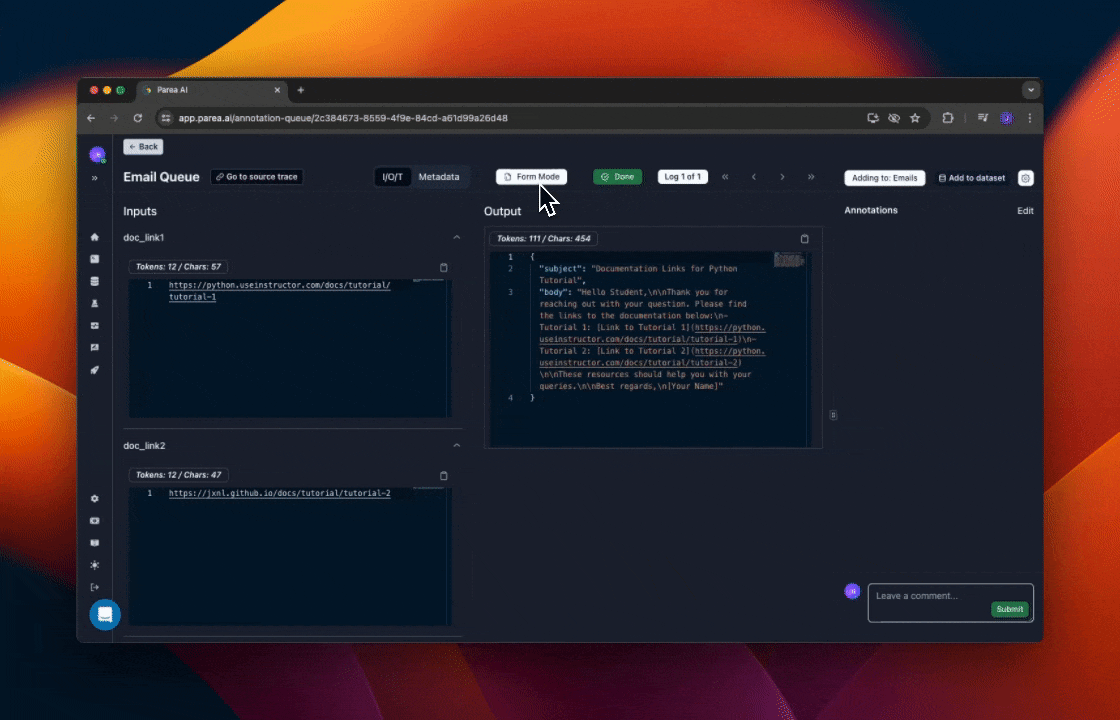Parea for Observing, Testing & Fine-tuning of Instructor
Parea is a platform that enables teams to monitor, collaborate, test & label for LLM applications. In this blog we will explore how Parea can be used to enhance the OpenAI client alongside instructor and debug + improve instructor calls. Parea has some features which makes it particularly useful for instructor:
- it automatically groups any related LLM calls under a single trace
- it automatically tracks any validation error counts & fields that occur when using
instructor - it provides a UI to label JSON responses by filling out a form instead of editing JSON objects
Configure Parea
Before starting this tutorial, make sure that you've registered for a Parea account. You'll also need to create an API key.
Example: Writing Emails with URLs from Instructor Docs
We will demonstrate Parea by using instructor to write emails which only contain URLs from the instructor docs. We'll need to install our dependencies before proceeding so simply run the command below.
Parea is dead simple to integrate - all it takes is 2 lines of code, and we have it setup.
import os
import instructor
import requests
from dotenv import load_dotenv
from openai import OpenAI
from pydantic import BaseModel, field_validator, Field
import re
from parea import Parea #(1)!
load_dotenv()
client = OpenAI()
p = Parea(api_key=os.getenv("PAREA_API_KEY")) #(2)!
p.wrap_openai_client(client, "instructor")
client = instructor.from_openai(client)
- Import
Pareafrom thepareamodule - Setup tracing using their native integration with
instructor
In this example, we'll be looking at writing emails which only contain links to the instructor docs. To do so, we can define a simple Pydantic model as seen below.
class Email(BaseModel):
subject: str
body: str = Field(
...,
description="Email body, Should contain links to instructor documentation. ",
)
@field_validator("body")
def check_urls(cls, v):
urls = re.findall(r"https?://(?:[-\w.]|(?:%[\da-fA-F]{2}))+", v)
errors = []
for url in urls:
if not url.startswith("https://python.useinstructor.com"):
errors.append(
f"URL {url} is not from useinstructor.com, Only include URLs that include use instructor.com. "
)
response = requests.get(url)
if response.status_code != 200:
errors.append(
f"URL {url} returned status code {response.status_code}. Only include valid URLs that exist."
)
elif "404" in response.text:
errors.append(
f"URL {url} contained '404' in the body. Only include valid URLs that exist."
)
if errors:
raise ValueError("\n".join(errors))
return
Now we can proceed to create an email using above Pydantic model.
email = client.messages.create(
model="gpt-3.5-turbo",
max_tokens=1024,
max_retries=3,
messages=[ #(1)!
{
"role": "user",
"content": "I'm responding to a student's question. Here is the link to the documentation: {{doc_link1}} and {{doc_link2}}",
}
],
template_inputs={
"doc_link1": "https://python.useinstructor.com/docs/tutorial/tutorial-1",
"doc_link2": "https://jxnl.github.io/docs/tutorial/tutorial-2",
},
response_model=Email,
)
print(email)
- Parea supports templated prompts via
{{...}}syntax in themessagesparameter. We can pass the template inputs as a dictionary to thetemplate_inputsparameter.
If you follow what we've done, Parea has wrapped the client, and we wrote an email with links from the instructor docs.
Validation Error Tracking
To take a look at trace of this execution checkout the screenshot below. Noticeable:
- left sidebar: all related LLM calls are grouped under a trace called
instructor - middle section: the root trace visualizes the
templated_inputsas inputs and the createdEmailobject as output - bottom of right sidebar: any validation errors are captured and tracked as score for the trace which enables visualizing them in dashboards and filtering by them on tables

We can see that while the email was successfully created, there was a validation error which meant that additional cost & latency were introduced because of the initially failed validation.
Label Responses for Fine-Tuning
Sometimes you may want to let subject-matter experts (SMEs) label responses to use them for fine-tuning. Parea provides a way to do this via an annotation queue. Editing raw JSON objects to correct tool use & function calling responses can be error-prone, esp. for non-devs. For that purpose, Parea has a so-called Form Mode which allows the user to safely fill-out a form instead of editing the JSON object. The labeled data can then be exported and used for fine-tuning.

Export Labeled Data & Fine-Tune
After labeling the data, you can export them as JSONL file:
from parea import Parea
p = Parea(api_key=os.getenv("PAREA_API_KEY"))
dataset = p.get_collection(DATASET_ID) #(1)!
dataset.write_to_finetune_jsonl("finetune.jsonl") #(2)!
- Replace
DATASET_IDwith the actual dataset ID - Writes the dataset to a JSONL file
Now we can use instructor to fine-tune the model:
